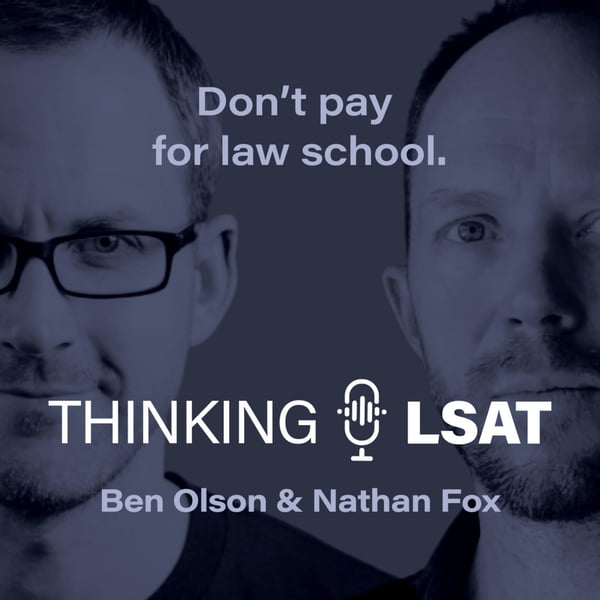When Students Reject Law Schools (Ep. 501)
Thinking LSAT
Nathan Fox and Ben Olson
4.8 • 868 Ratings
🗓️ 7 April 2025
⏱️ 68 minutes
🧾️ Download transcript
Summary
Ben and Nathan focus on shifting the power dynamic in law school admissions. From controlling scholarship negotiations to spotting misleading admissions practices, they offer practical advice for staying in control and making informed decisions. Sometimes, that means rejecting law schools that aren’t making the cut when it comes to scholarship offers.
0:35 – How Often Do Students Reject Schools - If you’re not turning down offers, you didn’t apply to enough schools. Applying broadly puts applicants in the driver’s seat and creates leverage for better offers. Nathan and Ben explain how schools are under pressure to fill their class and how savvy students can use that to negotiate their scholarship offers. They also caution against binding early decision programs, 3+3 tracks, and anything else that limits a student's ability to apply broadly.
14:23 – Is the Scholarship Estimator Broken - Two students express concern over their scholarship prospects. The updated 2024 ABA reports in the estimator appear less optimistic than earlier estimates. Nathan and Ben explain how changes to reporting standards might allow law schools to deflate reported scholarship numbers and obscure actual financial outcomes. They emphasize the importance of focusing on getting the best score possible on the LSAT, applying broadly, and not panicking.
33:22 – Eliminating Wrong Answers as a Strategy - There are two ways to get a question right: identifying the correct answer or eliminating the wrong ones. While the latter can work, it’s not the most efficient method. Ben and Nathan caution students against eliminating an answer choice because they don’t understand it. The preferred strategy is understanding why the right answer is correct, which often saves time and improves accuracy.
36:53 – Personal Statement Gong Show - Nathan and Ben continue their “gong show” series, reading listener-submitted personal statements. The guys read until they find something that derails the statement and then immediately stop. The current record stands at five lines. This week, James submits his essay in an attempt to beat the record.
44:27 – What’s the Deal with Southwestern Law School - Southwestern still uses conditional scholarships that Nathan and Ben classify as “scammerships.” Nearly 50% of students had their scholarships eliminated while in school. While the top students may thrive, the majority face poor employment outcomes and low bar passage rates. They advise listeners not to attend Southwestern at full or even half price. Anyone facing a scholarship cut should be prepared to drop out. They also discuss Southwestern’s part-time, online, and accelerated JD programs. These options might be more convenient, but they usually cost just as much as the regular three-year JD.
1:03:09 – Word of the Week - Many economists argue that tariffs create market distortions that can harm domestic consumers over time.
Transcript
Click on a timestamp to play from that location
| 0:00.0 | And so if you do something like 3 plus 3, binding early decision, or if you only apply to one school, you're, you know, it's like you're only shopping for one car. |
| 0:13.9 | And you're just like, I don't care what the price is. |
| 0:41.0 | Hello and welcome to episode 501 of the Thinking LSAT podcast. I'm Ben Olson. With me is Nathan Fox. We're the co-founders of Elsaid Demon.com and the Elsaid Demon Daily podcast. Today we're going to start this episode with law school reject rates. Nate, |
| 0:45.4 | this is something that you love to talk about on the show. We like to talk about how schools get rejected because everybody's obsessed about getting in and that's not what they should be |
| 0:50.6 | obsessed about. What did you find here? Well, this is all just from public data, |
| 0:56.0 | right? Using the ABA data, yield is on the form. Yield is how many people did you admit, |
| 1:04.8 | and then how many of those people actually enrolled? And that doesn't really mean anything to applicants. I don't think students resonate |
| 1:14.1 | with the idea of yield very well. Yeah, sure. If you do one minus yield, you get what I'm calling |
| 1:21.6 | reject rate. And reject rate is how often are applicants who were admitted telling the school, |
| 1:31.3 | no, thanks. |
| 1:32.3 | I've got better offers. |
| 1:34.5 | Yeah. |
| 1:35.0 | And the one shocking thing that you see right off the bat is that there are only two schools |
| 1:41.0 | that have a reject rate under 50%. |
| 1:45.0 | Yeah. |
| 1:46.4 | And you could probably predict what those two schools would be, or at least you could name |
| 1:51.3 | two out of the three. |
| 1:53.8 | You know it's going to be some combination of Harvard, Stanford, Yale. |
| 1:58.6 | So it's Yale and Harvard. |
| 2:00.7 | Yale rarely gets rejected. Last year, they made |
| 2:05.0 | 229 offers. They enrolled 174 students. So that's a reject rate of only 24%. If you get that |
| 2:13.7 | offer from Yale, only 24% of the time, still 24%, but only 24% of people admitted to Yale |
... |
Please login to see the full transcript.
Disclaimer: The podcast and artwork embedded on this page are from Nathan Fox and Ben Olson, and are the property of its owner and not affiliated with or endorsed by Tapesearch.
Generated transcripts are the property of Nathan Fox and Ben Olson and are distributed freely under the Fair Use doctrine. Transcripts generated by Tapesearch are not guaranteed to be accurate.
Copyright © Tapesearch 2025.

